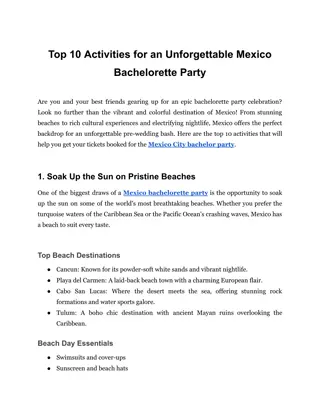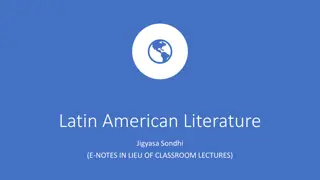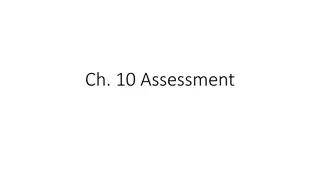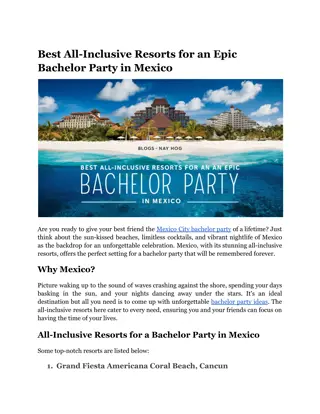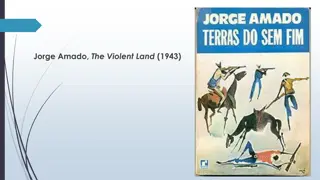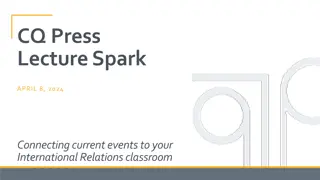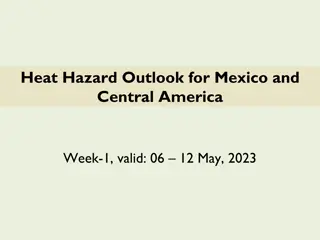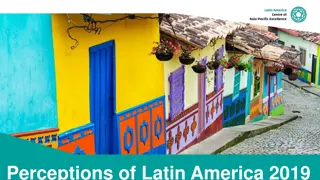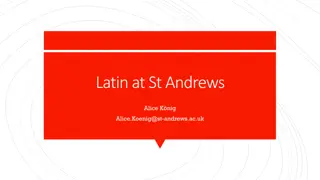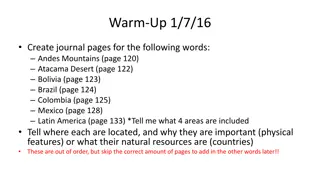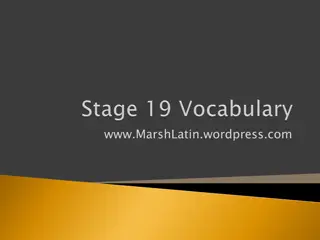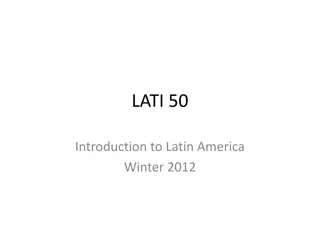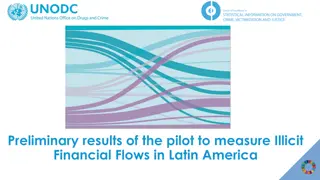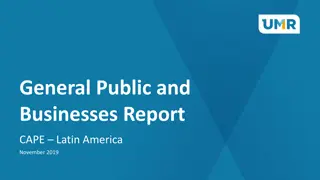Latin America - Mexico, Central America, South America
This unit covers the geographical aspects of Latin America, focusing on Mexico, Central America, South America, and The Caribbean. Students will delve into the diverse landscapes, cultures, and histories of these regions, enhancing their understanding of the unique characteristics that define Latin America. Chapters 8-10 provide valuable insights into the rich tapestry of this vibrant part of the world, offering a comprehensive exploration of the factors shaping its identity.
Download Presentation

Please find below an Image/Link to download the presentation.
The content on the website is provided AS IS for your information and personal use only. It may not be sold, licensed, or shared on other websites without obtaining consent from the author.If you encounter any issues during the download, it is possible that the publisher has removed the file from their server.
You are allowed to download the files provided on this website for personal or commercial use, subject to the condition that they are used lawfully. All files are the property of their respective owners.
The content on the website is provided AS IS for your information and personal use only. It may not be sold, licensed, or shared on other websites without obtaining consent from the author.
E N D
Presentation Transcript
WORLD GEOGRAPHY VOCABULARY UNIT 3, Chapters 8-10 -- LATIN AMERICA (Mexico, Central America, South America, & The Caribbean)
The physical geography of latin America: The Andes consist of parallel mountain ranges, or _____. cordilleras The high plain encircled by the Andes of Bolivia and Peru is known as the _____. altiplano The plateau of the Brazilian Highlands plunges sharply to the Atlantic Ocean, forming a steep cliff called an _____. escarpment Cattle are raised on the broad grasslands called _____ in Columbia and Venezuela and _____ in Argentina and Uruguay. llanos; pampas The R o de la Plata is typical of an _____, an area where the tide meets a river current. estuary
Quebrada Utla, Cordillera Blanca trek, Cordillera Blanca, IN PERU S. AMERICA
More physical geography of latin America: The world's largest rain forest is located in the _____. Amazon Basin South America's two main grassland areas are called: _____ and _____. llanos and pampas The three major geographic areas within Latin America are: _____, _____, and ______. Middle America, the Caribbean, and South America The three island groups that make up the West Indies are: _____, _____, and _____. the Bahamas, the Greater Antilles, and the Lesser Antilles The three rivers that flow into the R o de la Plata are: _____, _____, and _____. Paran , Paraguay, and Uruguay Rivers
The amazon basin is beautiful; but it can be deadly too!
Climate zones of latin America --t Highland climates are divided into vertical zones, including the hot _____, the temperate _____, and the cold _____. tierra caliente; tierra templata; tierra fr a The eight climate regions of Latin America are: _____, _____, _____, _____, _____, _____, _____ , and _____. tropical rain forest, tropical savanna, humid subtropics, desert and steppe, marine west coast, and Mediterranean The factors that determine why Latin America's highlands climate is divided into three zones are: _____ and _____. elevation and latitude
Clouds on the terraced fields of Zumbahua in Ecuadorian Altiplano. HIGHLAND Andes near Quilotoa lagoon, South America
some historical facets of latin america Native; original inhabitant: Indigenous Knotted cords used by keeping accounts: quipu Spanish or Portuguese conqueror: conquistadors Government officials appointed by European monarchs: viceroys Mayan picture writing: Glyphs The three indigenous Latin American empires are: _____, _____, and _____. Maya, Aztec, and Inca North American revolutions, wanting more rights for the lower classes, and anger and resent against Europe's rule fueled the movement for _____. Latin American independence
cultural aspects of latin america The ancient art form that inspired the region's wall painters is _____. mural paintings The sports that are most popular in Latin America are: _____, _____, _____, _____, and _____. f tbol, baseball, basketball, volleyball, and jai alai Mixing of diverse religious traditions: syncretism Designs made by setting small pieces of small stone, tile or shell into mortar: mosaic Grandparents, aunts, uncles and cousins: extended family Two language variations: dialect
*Street art murals in Cerro Polanco. Valparaiso, Chile, South America
human geography of latin america A city that dominates its country's economy and government: primate city A city with more than 10 million inhabitants: megacity Migration from rural areas to cities: urbanization Condition caused by lack of food: malnutrition Most of South America's population is located along the _____. coasts The region's population density is unbalanced because _____, _____, _____, and _____. temperature extremes, dense rain forests, towering mountains, and arid deserts
Many South American MEGACITIES are like this one: extreme wealth right next to FAVELAS (slums or ghettos) poverty




